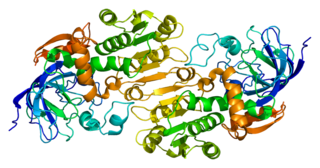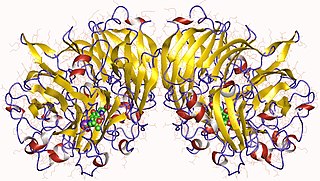Related Research Articles

Methanol (also called methyl alcohol and wood spirit, amongst other names) is an organic chemical and the simplest aliphatic alcohol, with the formula CH3OH (a methyl group linked to a hydroxyl group, often abbreviated as MeOH). It is a light, volatile, colourless, flammable liquid with a distinctive alcoholic odour similar to that of ethanol (potable alcohol). A polar solvent, methanol acquired the name wood alcohol because it was once produced chiefly by the destructive distillation of wood. Today, methanol is mainly produced industrially by hydrogenation of carbon monoxide.

Alcohol dehydrogenases (ADH) (EC 1.1.1.1) are a group of dehydrogenase enzymes that occur in many organisms and facilitate the interconversion between alcohols and aldehydes or ketones with the reduction of nicotinamide adenine dinucleotide (NAD+) to NADH. In humans and many other animals, they serve to break down alcohols that otherwise are toxic, and they also participate in generation of useful aldehyde, ketone, or alcohol groups during biosynthesis of various metabolites. In yeast, plants, and many bacteria, some alcohol dehydrogenases catalyze the opposite reaction as part of fermentation to ensure a constant supply of NAD+.

Pyrroloquinoline quinone (PQQ), also called methoxatin, is a redox cofactor and antioxidant. Produced by bacteria, it is found in soil and foods such as kiwifruit, as well as human breast milk. Enzymes using PQQ as a redox cofactor are called quinoproteins and play a variety of redox roles. Quinoprotein glucose dehydrogenase is used a glucose sensor in bacteria. PQQ stimulates growth in bacteria. Eukaryote targets, including mammalian lactate dehydrogenase, are of more interest to health. It is suggested that PQQ taken as a dietary supplement could promote mitochondrial biogenesis via this pathway as well as PGC-1α.
Methylotrophs are a diverse group of microorganisms that can use reduced one-carbon compounds, such as methanol or methane, as the carbon source for their growth; and multi-carbon compounds that contain no carbon-carbon bonds, such as dimethyl ether and dimethylamine. This group of microorganisms also includes those capable of assimilating reduced one-carbon compounds by way of carbon dioxide using the ribulose bisphosphate pathway. These organisms should not be confused with methanogens which on the contrary produce methane as a by-product from various one-carbon compounds such as carbon dioxide. Some methylotrophs can degrade the greenhouse gas methane, and in this case they are called methanotrophs. The abundance, purity, and low price of methanol compared to commonly used sugars make methylotrophs competent organisms for production of amino acids, vitamins, recombinant proteins, single-cell proteins, co-enzymes and cytochromes.

Fomepizole, also known as 4-methylpyrazole, is a medication used to treat methanol and ethylene glycol poisoning. It may be used alone or together with hemodialysis. It is given by injection into a vein.
Pink-Pigmented Facultative Methylotrophs, commonly abbreviated to PPFMs, are bacteria that are members of the genus Methylobacterium and are commonly found in soil, dust, various fresh water supplies and on plant surfaces. Although Gram negative, Methylobacteria often stain gram variable and are easily isolated using methanol-based mineral medium. Their pigmentation, which is frequently pink but may also be yellow or orange, is thought to provide protection from solar UV radiation which damages the DNA of bacteria at low doses because of their small cell size. This color is present due to the carotenoid pigments within the cell.

Pyruvate dehydrogenase phosphatase catalytic subunit 1, also known as protein phosphatase 2C, is an enzyme that in humans is encoded by the PDP1 gene. PDPC 1 is an enzyme which serves to reverse the effects of pyruvate dehydrogenase kinase upon pyruvate dehydrogenase, activating pyruvate dehydrogenase.

Methylobacterium is a genus of Hyphomicrobiales.
Methylorubrum extorquens is a Gram-negative bacterium. Methylorubrum species often appear pink, and are classified as pink-pigmented facultative methylotrophs, or PPFMs. The wild type has been known to use both methane and multiple carbon compounds as energy sources. Specifically, M. extorquens has been observed to use primarily methanol and C1 compounds as substrates in their energy cycles. It has been also observed that use lanthanides as a cofactor to increase its methanol dehydrogenase activity

A hangover is the experience of various unpleasant physiological and psychological effects usually following the consumption of alcohol, such as wine, beer, and liquor. Hangovers can last for several hours or for more than 24 hours. Typical symptoms of a hangover may include headache, drowsiness, concentration problems, dry mouth, dizziness, fatigue, gastrointestinal distress, absence of hunger, light sensitivity, depression, sweating, nausea, hyper-excitability, irritability, and anxiety.

In enzymology, an alcohol oxidase (EC 1.1.3.13) is an enzyme that catalyzes the chemical reaction

Aldo-keto reductase family 1 member C3 (AKR1C3), also known as 17β-hydroxysteroid dehydrogenase type 5 is a key steroidogenic enzyme that in humans is encoded by the AKR1C3 gene.

10-formyltetrahydrofolate dehydrogenase is an enzyme that in humans is encoded by the ALDH1L1 gene.

Methanol dehydrogenase (cytochrome c) (EC 1.1.2.7, methanol dehydrogenase, MDH) is an enzyme with systematic name methanol:cytochrome c oxidoreductase. This enzyme catalyses the following chemical reaction
Alcohol dehydrogenase (quinone) is an enzyme with systematic name alcohol:quinone oxidoreductase. This enzyme catalyses the following chemical reaction
Methanol dehydrogenase (nicotinoprotein) is an enzyme with systematic name methanol:acceptor oxidoreductase. This enzyme catalyses the following chemical reaction
Methylocella silvestris is a bacterium from the genus Methylocella spp which are found in many acidic soils and wetlands. Historically, Methylocella silvestris was originally isolated from acidic forest soils in Germany, and it is described as Gram-negative, aerobic, non-pigmented, non-motile, rod-shaped and methane-oxidizing facultative methanotroph. As an aerobic methanotrophic bacteria, Methylocella spp use methane (CH4), and methanol as their main carbon and energy source, as well as multi compounds acetate, pyruvate, succinate, malate, and ethanol. They were known to survive in the cold temperature from 4° to 30° degree of Celsius with the optimum at around 15° to 25 °C, but no more than 36 °C. They grow better in the pH scale between 4.5 to 7.0. It lacks intracytoplasmic membranes common to all methane-oxidizing bacteria except Methylocella, but contain a vesicular membrane system connected to the cytoplasmic membrane. BL2T (=DSM 15510T=NCIMB 13906T) is the type strain.

Methanol toxicity is poisoning from methanol, characteristically via ingestion. Symptoms may include a decreased level of consciousness, poor or no coordination, hypothermia, vomiting, abdominal pain, and a specific smell on the breath. Decreased vision may start as early as twelve hours after exposure. Long-term outcomes may include blindness and kidney failure. Blindness may occur after drinking as little as 10mL; death may occur after drinking quantities over 15 mL.
Methylobacterium organophilum is a facultatively methylotrophic bacteria from the genus of Methylobacterium which was isolated from sediments from the Lake Mendota in Madison in the United States. Methylobacterium organophilum can degrade methanol.
Methylacidiphilum fumariolicum is an autotrophic bacterium first described in 2007 growing on volcanic pools near Naples, Italy. It grows in mud at temperatures between 50 °C - 60 °C and an acidic pH of 2–5. It is able to oxidize methane gas. It uses ammonium, nitrate or atmospheric nitrogen as a nitrogen source and fixes carbon dioxide.
References
- ↑ Garrity GM, Brenner DJ, Krieg NR, Staley JT, eds. (2005). Bergey's Manual of Systematic Bacteriology, Volume Two: The Proteobacteria, Part C: The Alpha-, Beta-, Delta-, and Epsilonproteobacteria. New York, New York: Springer. ISBN 978-0-387-24145-6..
- ↑ Hibi Y, Asai K, Arafuka H, Hamajima M, Iwama T, Kawai K (May 2011). "Molecular structure of La3+-induced methanol dehydrogenase-like protein in Methylobacterium radiotolerans". Journal of Bioscience and Bioengineering. 111 (5): 547–549. doi:10.1016/j.jbiosc.2010.12.017. PMID 21256798.
- ↑ Keltjens, Jan T.; Pol, Arjan; Reimann, Joachim; Op den Camp, Huub J. M. (May 13, 2014). "PQQ-dependent methanol dehydrogenases: rare-earth elements make a difference". Applied Microbiology and Biotechnology. 98 (14): 6163–6183. doi:10.1007/s00253-014-5766-8. ISSN 0175-7598. PMID 24816778. S2CID 253773622.